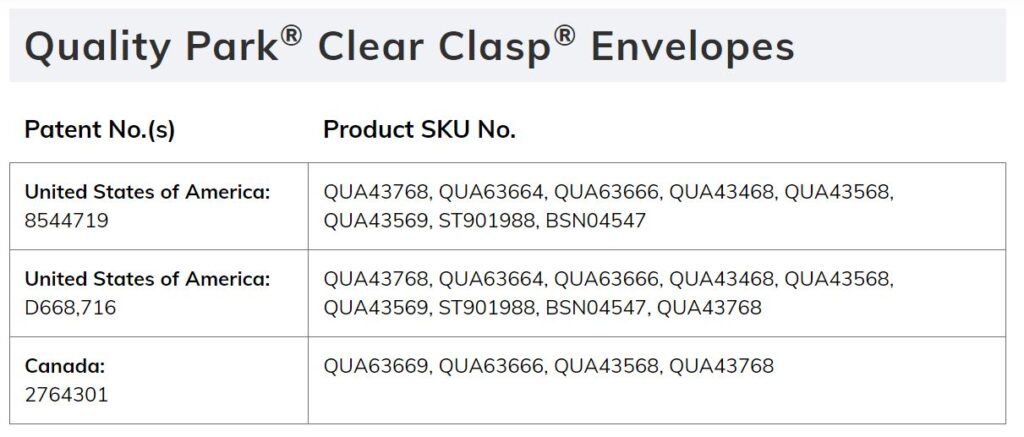As a patent holder, you’ve invested significant time, resources, and effort into developing your innovation. While securing patents is critical to protecting your intellectual property, it’s only the beginning of the journey. Many companies, especially smaller ones, often overlook the importance of patent marking when commercializing their intellectual property. Without properly marking your products, you risk losing significant potential earnings by limiting your ability to claim damages in patent infringement cases.
Did you know that as per 35 U.S. Code § 292(a), any false patent marking on your products can lead to a hefty fine of $500 per falsely marked item? The penalty for incorrectly marking 2,000 products could be as high as $ 1,000,000. The consequences of false marking are not to be taken lightly.
In this article, we will dive into the role of patent marking, the legal standards that apply, the consequences of false patent marking, and the value of regular Patent Marking Compliance checks to ensure compliance. We’ll also explore how virtual patent marking simplifies the process and why partnering with Evalueserve for comprehensive Patent Marking & Compliance solutions can help ensure you stay compliant and maximize the value of your patents, as legally, it is the patent owner’s responsibility to demonstrate compliance with marking regulations.
Who & Why You Should Read This?
- Patent Owners: Gain a clear understanding of how accurate patent marking can impact your ability to recover damages and assert your rights. Learn about the potential financial impact of false patent marking and how to avoid it.
- Legal and IP Professionals: Gain insights into how patent marking compliance can support litigation strategies and avoid penalties.
- Business Leaders: Discover the financial risks associated with incorrect or absent patent marking and why it’s crucial to your company’s IP strategy. This information can help you make informed decisions and protect your company’s intellectual property.
- Product Development Teams: Discover the importance of regular Compliance checks in integrating patent marking into your product development process. This practice can prevent costly mistakes and ensure compliance with the law, enhancing the value of your patents.
Key Takeaways
- Why Patent Marking is Critical: Proper patent marking provides notice to infringers and allows patent holders to claim maximum damages. With proper marking, you may be able to recover damages for the time leading up to the discovery of the infringement.
- False Patent Marking Penalties: Intentionally incorrect patent markings can result in fines of up to $500 per falsely marked item.
- Advantages of Virtual Patent Marking: Virtual marking provides flexibility and can simplify compliance, but it must be done correctly with clear associations between products and patents.
- Case Law Supporting Proper Marking: Cases like American Medical Systems v. Medical Engineering Corp. emphasize the importance of patent marking in legal proceedings.
- Importance of Regular Compliance Checks: By conducting patent marking Compliance checks, you can proactively prevent costly mistakes and ensure compliance with the law. This regular practice puts you in control of your patent marking strategy.
What is Patent Marking and Why It’s Important
Patent marking involves labeling a product with relevant patent information, letting the public know it is protected. This labeling serves as constructive notice to potential infringers, providing legal evidence that they know your patent rights. Proper marking enables you to recover damages from the earliest point of infringement.
According to 35 U.S.C. § 287(a), patent holders must label their products with the relevant patent numbers or, when using virtual marking, provide a web link where these patents are listed. Without such marking, you may only be entitled to damages from the date the infringer receives actual notice—such as when a lawsuit is filed or a legal notice is served.
Even though ordinary citizens can no longer file false marking lawsuits to recover statutory damages, and only the government has the authority to pursue these cases, Individuals who suffer competitive injuries due to false patent marketing can sue for compensatory damages. These laws were enacted following a verdict that found no violation of patent marking laws in a lawsuit claiming damages exceeding $10 trillion (Pequignot v. Solo Cup Co., 608 F.3d 1356, Fed. Cir. 2010).
Legal Requirements for Patent Marking
Under U.S. law, precisely 35 U.S.C. § 287(a), patent holders must mark their products to be eligible to claim damages for patent infringement. This law ensures that the public knows the patent rights associated with a product, discouraging unauthorized use of patented technology.
In American Medical Systems v. Medical Engineering Corp., the court clarified that failure to mark a patented product limits your ability to recover damages from the beginning of infringement. Instead, you may only recover damages starting when the infringer was notified.
Similarly, 35 U.S.C. § 292 governs false patent marking, which refers to labeling products with incorrect patent numbers intending to deceive. This can result in steep fines—up to $500 per falsely marked item—making compliance essential to avoid penalties.
How to Properly Mark Patented Products
To maximize the benefits of your patent protection and ensure you’re entitled to total damages for infringement, you must ensure that your products are accurately marked before entering the market.
1. Traditional Patent Marking:
- On the Product: Products should display the word “Patent” or “Pat.” followed by the relevant patent number.
- On the Packaging: If it’s impractical to mark the product itself, the packaging can be marked instead.

2. Virtual Patent Marking:
- Web-Based Marking: Virtual patent marking lets you list patents on a website. The website URL must associate each specific product with its applicable patent numbers, as required by 35 U.S.C. § 287(a). The product, packaging, or label should be distinctly marked in the following manner:
Patent or Pat. Followed by the internet address, for example:
- Patent: www.company.com/patent
- Pat.: www.company.com/patent
Pro Tips:
- It’s critical that virtual marking is not just a list of patents; the website should connect each product with its relevant patents. If not done correctly, as noted in Manufacturing Resources Int’l v. Civiq Smartscapes, LLC, the website may be considered a “research project” for the public and fail to provide adequate legal notice.
- Terms like “Patent Applied For” or “Patent Pending” only indicate that a patent application has been filed and has no legal effect until the patent is granted. Misuse of these terms can lead to fines and damages for competitive injury.
Benefits of Virtual Patent Marking
Using virtual patent marking offers many advantages:
- Easy Updates: Updating a website is more straightforward than modifying physical product molds or packaging.
- Cost Efficiency: Virtual marking reduces costs associated with retooling or reprinting packaging whenever patent status changes.
- Comprehensive Coverage: For products covered by multiple patents, virtual marking allows you to list all relevant patents in one easily accessible location.
Example of Virtual Patent Marking Format:

This format ensures your patent information is easily accessible, reducing non-compliance risk and enhancing legal protection.
Real-world Examples of Virtual Patent Marking:
1. Vitamix – The Quiet One (CL-VM50031-2133)

The Risks of Improper or False Patent Marking
Please properly mark your products to ensure your ability to recover damages in an infringement case. With correct marking, you may be able to claim damages starting from when the infringer receives actual notice of the patent.
Conversely, false patent marking can expose you to substantial fines. If you deliberately mislead the public by marking products with patents that don’t apply, you could face fines of up to $500 per incorrectly marked item under 35 U.S.C. § 292.
Why Conduct Patent Marking Compliance Checks?
Patent marking requires continuous monitoring and regular compliance checks to ensure compliance. A compliance check should ensure all products are marked correctly with accurate and up-to-date patent information.
Focus areas of a compliance check include:
- Accuracy: Verifying that the marked patents apply to the product.
- Consistency: Ensuring that all versions of the product are consistently marked.
- Relevance: Removing patents that have expired or are no longer applicable. It is important to note that though 35 U.S.C § 292(c) explicitly mentions that the presence of expired patents in patent marking is not a ‘violation of 35 U.S.C § 292(a)’ so that is not considered as false patent marking., it is regarded as a good practice to remove expired patents from patent marking of a product when the patent expires or is abandoned.
Conducting routine compliance checks as part of your IP audit can help prevent legal complications and ensure your company stays compliant, minimizing the risk of limited damages or penalties for false markings.
How can Evalueserve’s Patent Marking Solutions Help?
Patent marking can be complex, especially for companies managing large product portfolios or operating in multiple jurisdictions. Evalueserve provides Patent Marking as part of IP Audit and Compliance Solutions to help you navigate these complexities, ensure compliance, and protect your patent rights.
Our solutions include:
- Patent-to-Product Mapping: To ensure accurate marking, identify the correct patents for each product.
- Virtual Marking Support: Helping you set up and maintain compliant virtual patent marking systems.
- Regular Compliance Checks: Conducting regular compliance checks to verify that all products are marked correctly with accurate and up-to-date patent information.
- Training and Consultation: Offering guidance to ensure your teams understand the importance of accurate patent marking and how to stay compliant.
We understand how stressful litigation can be for patent owners, tiny companies, and inventors. A simple mistake in patent marking can determine whether you win or lose a case. Evalueserve is here to help you in your journey.
Conclusion
Patent marking is vital to any IP strategy and provides a foundation for maximizing recoverable damages in infringement cases. Failure to comply with patent marking regulations—or even worse, falsely marking products—can result in severe financial penalties and limited legal protections.
Don’t take chances with your intellectual property. Take the necessary steps to ensure compliance and update your patent marking practices. Whether you manage this process internally or rely on Evalueserve’s IP Audit & Compliance Solutions, staying compliant and protecting your valuable intellectual assets is essential.
Ready to optimize your patent marking? Contact Evalueserve IP and R&D today for expert guidance and support to ensure your patent marking strategy is compliant, up-to-date, and effective.
Talk to One of Our Experts
Get in touch today to find out about how Evalueserve can help you improve your processes, making you better, faster and more efficient.




